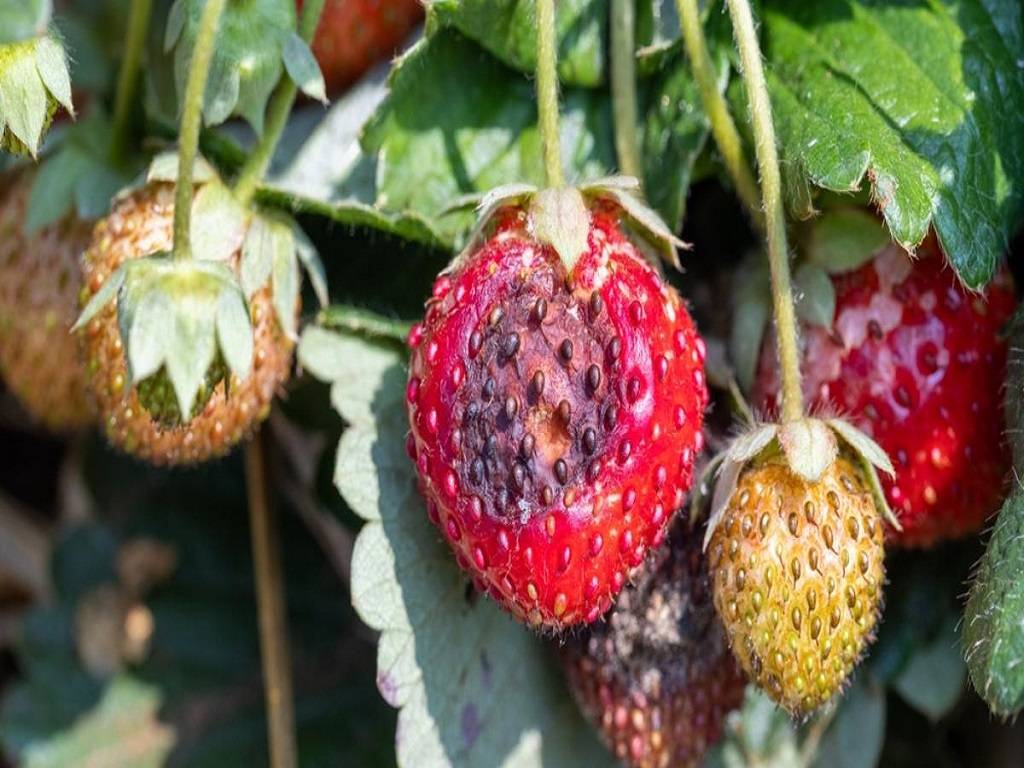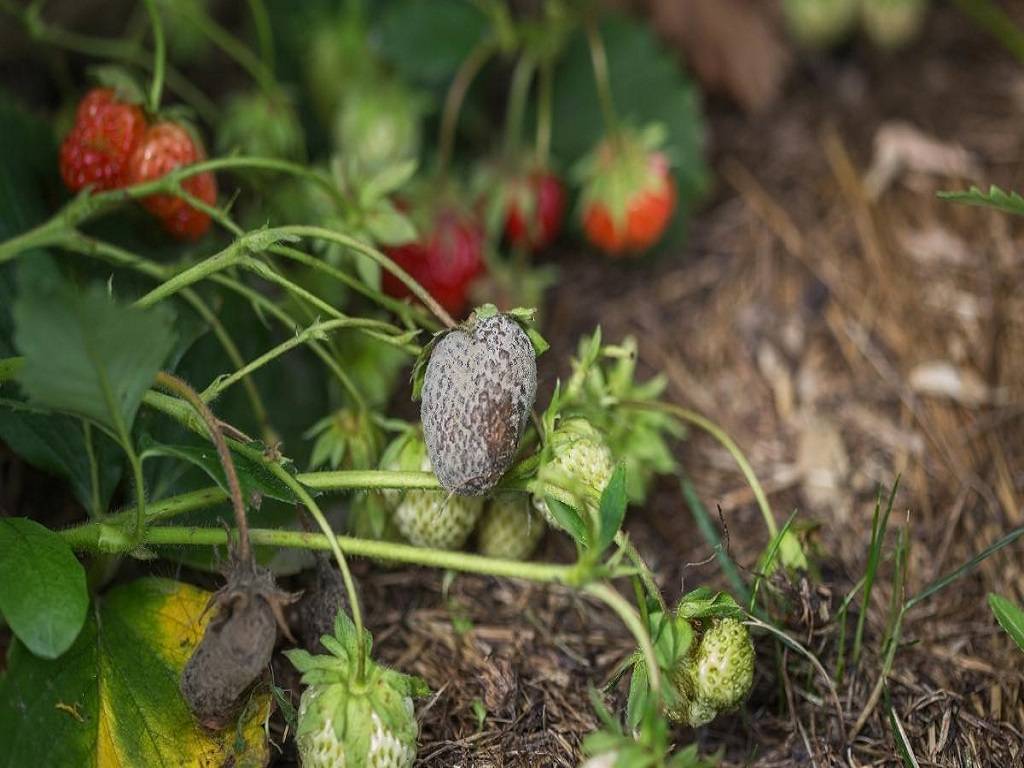
Strawberries are robust perennial plants that are simple to grow. However, they are not immune to many typical plant issues. Plant ailments have the potential to swiftly destroy your crop.
They are also vulnerable to several pests and diseases. When purchased, plants can have disease-causing organisms on them, or in the soil where they are planted. Wind, birds, insects, a worker's boots or shoes, and agricultural equipment, all have the potential to further spread these pests and diseases into the strawberry fields.
Losses in most places might be minimized by:
-
Using appropriate cultural techniques, such as crop rotation,
-
Choosing the varieties that are localized,
-
Choosing plants that are resistant to different pests,
-
Planting healthy plants.
Let us discuss some pests and diseases infecting the strawberry field:
1. Aphids
Aphids are tiny, soft-bodied insects that puncture stems, leaves, and other fragile plant components with their long, thin mouthparts to extract fluids. Aphid species that occasionally feed on plants can be found on almost every plant. And most aphid species can be managed in the same way.
Identification:
Depending on the species and the plants they feed on, aphids can be green, yellow, brown, red, or black and have soft, pear-shaped bodies with long legs and antennae. Some species secrete a waxy white or gray material across their body surface, giving them the appearance of being waxy or fuzzy.
Symptoms:
Aphids that feed on leaves in small to moderate numbers rarely cause harm to trees or gardens. Aphids can also generate significant amounts of honeydew, a sticky fluid that frequently turns black with the development of a fungus called sooty mold.
However, high numbers of aphids can cause leaves to turn yellow and stunt shoots. A poison that some aphid species inject into plants results in curled leaves, which further stunts development. Gall formations are caused by a few species. On some ornamental and vegetable plants, aphids can spread viruses from one plant to another.
Control:
Although aphids seldom harm mature plants, the harm they cause and the honeydew they produce occasionally call for management. Since most pesticides kill both the pest and beneficial insects, take into account the non-chemical measures outlined below. Aphids and the honeydew they generate can be an important food source for beneficial insects on older trees, such as those in citrus orchards.
2. Leaf Rollers
Caterpillars of many kinds roll the leaves in strawberries. Their appearance, head capsule colors, and geographic locations differ from region to region. When disturbed, the caterpillars frequently fiercely wriggle backward before dropping from the leaf hanging by a silken thread. When in repose, moths have a bell-like form.
Identification
The leafroller adult moths have a dark brown patch and a dark brown diagonal band on each wing. They are grayish-brown in color. Larvae have light brown heads with tiny, conspicuous black marks on either side. They are slender and grayish-green.
Symptoms:
White webbing is used to make shelters by tying one or more strawberry leaves together. Larvae can also make shelters by attaching leaves or the calyx sepals to fruit, and they can eat from these protected regions on the outside or inside of the fruit.
Control:
Pick up and kill caterpillars by hand. In the late winter, clear the base of plants of debris and dead leaves. Caterpillar populations can be naturally controlled by parasitic wasps. When populations are high, spot treatments of Bacillus thuringiensis or spinosad can be used.
3. Thrips
Thrips are little, elongated insects belonging to the Thysanoptera order. They feed by piercing the epidermal (outer) layer of the host tissue and sucking out the cell contents, which causes the leaf surface to become stippled, flecked with color, or silvered. Numerous types of thrips are often harmless and eat pollen and fungus spores. However, pollen feeding on plants like African violets and orchids can result in unattractive pollen deposits and could shorten the life of the flower. Some thrips are helpful predators that consume mites and other insects.
Identification:
The majority of mature thrips have long fringes on the edges of both pairs of their long, thin wings and are elongate, slender, and tiny (less than 1/20 inch long). Infants lack wings and are oblong, thin, and elongated (also known as larvae or nymphs). The majority of thrips are either transparent white, yellowish white, dark brown, or black in hue. Some species, like the recognizable reddish-orange larvae of the predatory thrips Franklinothrips orizabensis and F. vespiformis, are vividly colored.
Symptoms:
-
By rasping the plant's bud, flower, and leaf tissues and then swallowing the sap that is leaking, thrips, both nymphs and adults, can harm the plant.
-
The stigmas and anthers of strawberry blooms that have been fed by thrips prematurely turn brown and wither, but not before fertilization has taken place.
-
When populations are high, the berry's skin can break and turn discolored.
-
Surface rustling around planting materials from late green to mature fruit is considered fruit damage. The fruit can seem seedy and bronze-like.
-
The fruits will be sucking in thrips larvae and adults.
-
Around the planting supplies are brown, sucking spots covered with scaly skin.
Control:
Thrips are hard to eradicate. Use an integrated approach that incorporates the use of excellent cultural practices, natural enemies, and the most targeted or least toxic pesticides when control is required.
4. Nematode
Nematodes are little roundworms that resemble eels. The most problematic species in the garden are those that spend most of their lives in plant roots and eat plant roots, as well as those that live freely in the soil.
Damage Symptoms:
-
Patches of infected plants in the orchard
-
The main symptom is the development of galls on the host root system.
-
Roots begin to spread out widely from the gall tissue, resulting in the "beard root" symptom.
-
Knobby and tangled roots result from infection.
-
The root system and rootlets are virtually entirely missing in highly diseased plants. The roots' ability to absorb and transmit water and nutrients is severely hindered.
-
During the hottest portion of the day, especially under dry circumstances, plants wilt and frequently become stunted.
Control:
The control of nematodes is challenging. Preventive methods, such as sanitation and plant variety selection, are the most effective. Using soil solarization, crop rotation and fallowing helps lessen current infestations. These techniques only work for about a year since they mostly affect the top foot or so of soil, where nematodes are found.
They are best suited for annual plants or to help in the establishment of young woody plants. Once nematodes have infected a region or crop, it is best to move planting dates to colder seasons when worms are less active to reduce damage. Try to create the best possible circumstances for plant growth, such as enough watering and soil amendments to increase the resistance of plants to nematode infection.
5. Leaf Spot
One of the most prevalent strawberry diseases, leaf spot affects most cultivars globally.
Disease signs:
-
On the top leaf surface, tiny, deep purple, rounded to irregularly shaped dots at first develop.
-
These expand to a diameter of 3–6 mm. The cores remain dark red, while the margins change to brown, then grey, and lastly white color. Spots might combine and harm a leaf.
-
The fungal also causes superficial black patches on the fruit, fruit stalks, petioles, and stolons.
Survival and spread:
-
Diseased leaves from strawberry harvests both recent and past
-
Rain and overhead irrigation spraying water.
Control:
On strawberries, leaf spots can appear if the weather is moist or if you use sprinklers. Sprinklers can be replaced with drip or furrow irrigation to lessen the harshness. During damp weather, keep an eye out for the development of leaf spot illnesses. As soon as sick leaves develop, remove and destroy them. After each season, removing all older leaves can also help in limiting disease carryover.
6. Grey Mold
Strawberries are among the many fruits, vegetables, and flowers that are affected by this disease.

Disease signs:
-
Flowers, fruit, petioles, leaves, and stems will all be attacked by the fungus.
-
Fruit stalks and flowers that become infected while blossoming quickly perish. Fruit that is both green and ripe rots brown.
-
This covers the entire fruit, which is then coated in a thick layer of dry, gloomy spores.
-
The rot can begin anywhere on the fruit, although it is typically seen on the calyx end or the sides of fruit that are in contact with other rotten fruit.
Survival and spread:
-
The fungal infects floral parts and overwinters on plant detritus. After that, it either rots the fruit or remains dormant till the fruit ripens further. Throughout the fruiting season, spores are continually generated, and when they germinate, they infect plants.
-
by wind and rain or overhead irrigation sprinkling
Control:
Raised beds, plastic mulch to prevent fruit from touching the soil, and drip or furrow irrigation to keep water off the foliage and fruit can all help reduce fruit deterioration. Make sure the plants are sufficiently spaced apart to allow for enough airflow around the fruit.
It could be possible to increase circulation by using stepped planter boxes that enable fruit to dangle over the edges. To minimize the spread of disease, remove rotten fruit. Water plants in the morning if sprinklers are being used so that they will dry out during the day.
7. Powdery Mildew
Worldwide, the disease infects every strawberry crop. Each type has a different susceptibility; none are resistant.
Disease signs:
-
Early signs of the illness include the upward curling of the leaf edges.
-
The top leaf surfaces then develop uneven, purple blotching, frequently along prominent veins. The foliage appears fragile.
-
The thick clouds of spores that powdery mildew on other crops often produces are not present in this disease.
-
Fruit can be affected by powdery mildew at any stage.
-
Dull fruit, both young and old, with obvious planting materials
Control:
Preventative measures are the best way to control powdery mildew. In many cases, powdery mildew can be effectively controlled by avoiding the most vulnerable types and varieties and using proper cultural techniques. Where conditions are good, fungicide treatments can be necessary to preserve vulnerable fruit plants and berries. On nearly all grape and strawberry types, as well as on vulnerable apple cultivars, fungicide sprays are frequently required.










